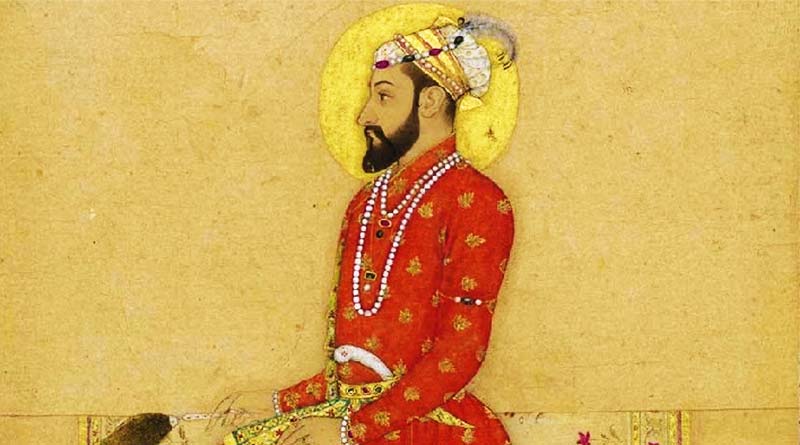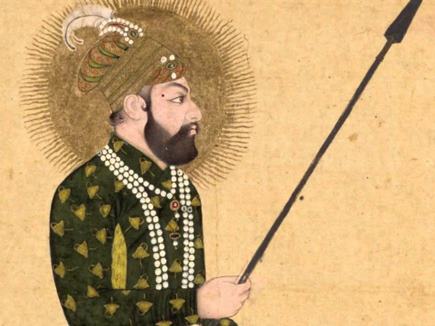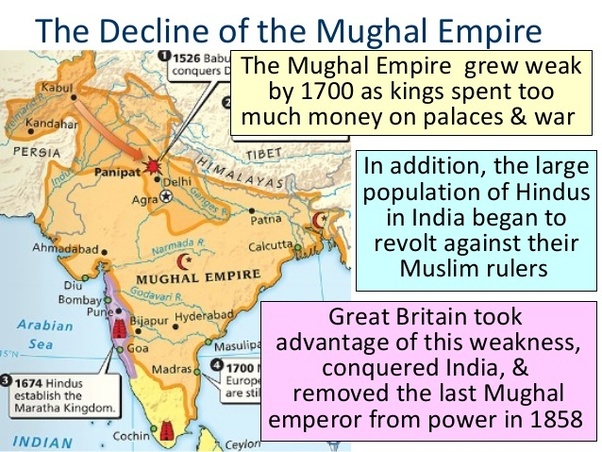The great Mughal Empire lost its glory and power during the mid of 18th century. The decline of the Mughal Empire reveals some of the defects and weaknesses of India’s medieval social, economic, and political structure which were responsible for the eventual subjugation of the country by the English East India Company.
Aurangzeb, the last Great Mughal emperor had-died in 1707 and left his Empire vulnerable. The leadership that emerged after was quite weak and ineffective. It opened opportunities for not only the royal princes, the rebellious governor in several provinces who were desperately looking for the opportunity of declaring themselves independent from Delhi.
Here is a brief chronology of Mughal Emperors after the death of Aurangzeb till the Battle of Buxar:
The Mughals After Aurangzeb
Mughals emperors who took the throne after Aurangzeb were mostly incompetent and greedy in nature. They had no faith in the welfare of their kingdom and citizens, all they wished to had to retain their title and a king-sized life so that they can live happily forever. Here is the list of those incompetent rulers who gave an opportunity to the British to capture the Hindustan from dying mighty Mughals.
Bahadur Shah (1707-1712)

After the death of Aurangzeb, his three sons fought among them for the throne which saw the emergence of 65-year-old Bahadur Shah emerged as victorious. He was learned, dignified, and more tolerant towards the Hindu chiefs and rajas. He was supported by Jat chief, Churaman in the campaign against Sikh leader Banda Bahadur.
Bahadur Shah also made peace with the Bundela chief, Chhatrasal who remained loyal to him. Due to his excessive reckless grants of jagirs and promotions, royal treasure amounting to some 13 crores of rupees were exhausted. Bahadur Shah was heading towards a solution to the problems destabilizing Mughal Empire but he died in 1712.
Jahandar Shah (1712 – 1713)

After Bahadur Shah’s death, a new element entered Mughal Empire’s politics i.e. the succeeding wars of succession. While previously the contest for the power had been between royal princes only, and the nobles had hardly any interference to the throne; now ambitious nobles became direct contenders for the power and used princes as mere pawns to capture the seats of authority.
In the civil war, one of Bahadur Shah’s weak sons, Jahandar Shah, won because he was supported by Zulfiqar Khan, the most powerful noble of the time. Jahandar Shah was a weak and degenerate prince who was wholly devoted to pleasure. He lacked good manners, dignity, and decency. During Jahandar Shah’s reign, the administration was virtually in the hands of the extremely capable and energetic Zulfiqar Khan, who was his wazir.
Zulfiqar Khan believed that it was necessary to establish friendly relations with the Rajput rajas and the Maratha Sardars and to conciliate the Hindu chieftains necessary to strengthen his position at the Court and to save the Empire. Therefore, he swiftly reversed the policies of Aurangzeb and abolished the hated jizya (tax). Jai Singh of Amber was given the title of Mira Raja Saint and appointed Governor of Malwa; Ajit Singh of Marwar was awarded the tide of Maharaja and appointed Governor of Gujarat.
Zulfiqar Khan attempted to secure the finances of the Empire by checking the reckless growth of jagirs and offices. He also tried to compel the (nobles) to maintain their official quota of troops. An evil tendency encouraged by him was that of ‘ijara’ or revenue-farming. Instead of collecting land revenue at a fixed rate as under Todar Mal’s land revenue settlement, the Government began to contract with revenue farmers and middlemen to pay the Government a fixed amount of money while they were left free to collect whatever they could from the peasant. This encouraged the oppression of the peasant. The cowardly Emperor could not dismiss the powerful Wajir (Zulfiqar Khan), but he began to intrigue against him secretly.
Farrukhsiyar (1713 – 1719)

Farrukhsiyar accredited the success to the Sayyid brothers- Abdullah Khan & Hussain Ali Khan Barha. He made these two wazir (manager of home & finance) & Mir Bakshi (manager of Army) respectively. The two brothers acquired control of the state with the most important functions viz. controlling the army & finances. Faruksiyar was inefficient in ruling as he was not only a coward and an undependable person but could not also control the Sayyid brothers.
Muhammad Shah (1719 – 1748)

Muhammad Shah was installed as the Mughal emperor by the Sayyid brothers who look de-facto control of the Empire in his name. They needed to reform the administrative structure to take effective control and consolidate their authority. Hence the brothers look following steps to reform the current administrative structure. They took up the policy of religious tolerance as they were convinced that India could be ruled harmoniously only by associating with Hindu chiefs, nobles, and common people.
They sought to conciliate with Jats, Bundelas, Rajputs, and Marathas by giving them high ranks in administration. They abolished Jizya (which is the extra tax imposed on non-Muslims who live under Muslim rule according to the Quran and Hadith). They Abolished the pilgrim tax. They reached an agreement with Shahu by granting Swarajya and the right to collect Chauth and Sardeshmukhi of six provinces of Deccan. In return, Shahu Agreed to provide military support with 15,000 mounted soldiers. Mohammad Shah’s long reign of nearly 30 years (1719-1748 A.D.) was the last chance of saving the empire.
Biggest Blow to the Mughal Empire: Nadir Shah’s Invasion
The condition of India with its incompetent rulers of the Mughal Empire, weak administration, and poor military strength attracted foreign invaders. Nadir Shah, the ruler of Persia, attacked Punjab in 1739. Mohammad Shah was easily defeated and imprisoned. Nadir Shah marched towards Delhi. Nadir Shah was a ferocious invader. He massacred thousands of people in Delhi. Delhi looked deserted for days.
Mohammad Shah, however, was reinstated on the throne. Nadir Shah carried with him the Kohinoor diamond and the Peacock throne of Shah Jahan. By plundering a big city like Delhi, he got enormous wealth. Nadir Shah’s invasion gave a crushing blow to the already tottering Mughal Empire and hastened the process of its disintegration. Mohammad Shah’s kingdom was practically confined to Delhi and its neighborhood. He died in 1748. Mohammad Shah was succeeded by several inefficient rulers such as:
- Ahmad Shah (1748-1754): Ahmed Shah inherited a much weakened Mughal state and after ruling unsuccessfully for 6 years, he was deposed by the Vizier Ghazi ud-Din Khan. He spent the remaining years of his life in prison and died of natural causes in January 1775. His son Bidar Baksh II temporarily rose to power in 1788 as a puppet of Ghulam Qadir.
- Alamgir II (1754-1759): During the rule of Alamgir II, the East India Company fought the Battle of Plassey in 1757 and defeated Siraj-ud-Daulah, the Nawab of Bengal. They thus got a foothold in Bengal.
- Shah Alam II (1759-1806): In 1761, during the reign of Shah Alam II, Ahmad Shah Abdali, the independent ruler of Afghanistan, invaded India. He conquered Punjab and marched towards Delhi. By this time, the Marathas had extended their influence up to Delhi. Hence a war between the Marathas and Ahmad Shah Abdali was inevitable. In the Third Battle of Panipat, the Marathas were completely defeated. They lost thousands of soldiers along with their very good generals. They were forced to retreat to the Deccan. Ahmad Shah Abdali’s invasion further weakened the Mughal Empire.
- Akbar II (1806-1837) and Bahadur Shah II (1837-1857)
Shah Alam II granted the Dewani of Bengal, Bihar, and Orissa to the East India Company in 1765. This allowed the Company to collect revenue from these areas. It also showed that Mughal authority was recognized by the Indian rulers. Mughal rule formally came to an end when Bahadur Shah was deposed and deported to Rangoon, Myanmar by the East India Company (1857).

